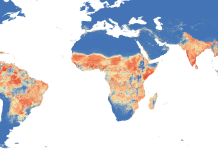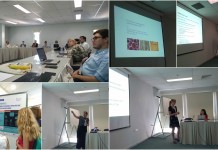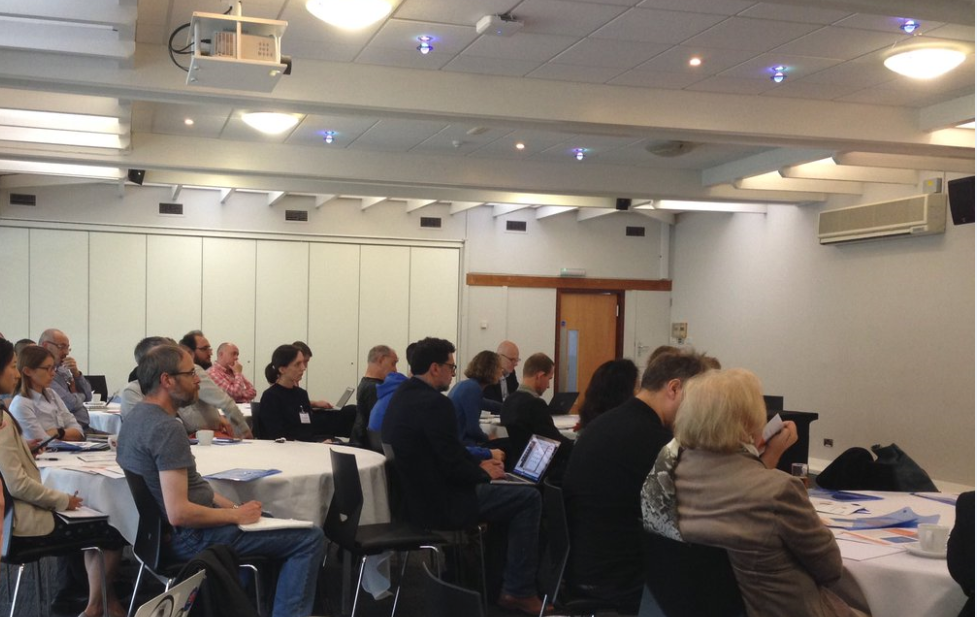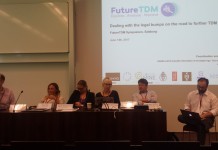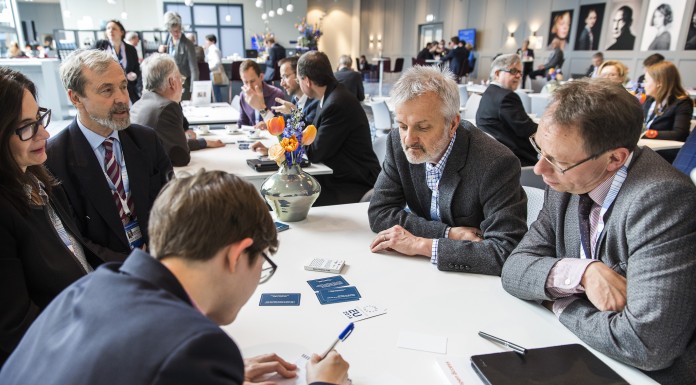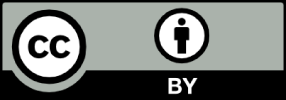Report 3: UK and EU TDM exception, contract override and APIs, wealth transfer[?]
This is the third of three blog posts on the iCLIC Data Mining and Data Sharing workshop's part on copyright and database law. The first two blog posts can be found here and here. Since I drafted this post the official workshop report has been published covering also the workshop's part on data protection.
Margaret Haig (UK IPO) started her presentation on the UK text and data mining (TDM) exception offering some context to the 2011 Hargreaves review: Publishers applied fees for TDM to be carried out and people got concerned as they probably had done some TDM in the past and therefore asked for a TDM exception. It was primarily the research community that was asking for it. After evidence gathering it was estimated that there could be efficiency savings of approximately £124m a year by introducing this exception. In effect since June 2014, the exception is limited to non-commercial research purpose, but not by type of beneficiary. It can include public private partnerships, if, for example, a commercial organisation has a non-commercial arm or wants to do pro bono research. The exception is justified by the language in the InfoSoc Directive and it has not been challenged at all.
The person making use of the TDM exception has to have "lawful access" to the analysed materials. Contractual barriers are void, because otherwise the exception would have no teeth. However, similar to the exception proposed on EU level [technical protection] measures (TPMs) can be put in place to keep the integrity of systems where the materials are accessed. Haig emphasised that the IPO would very much welcome information about projects making use of the exception. There will be an implementation review at some stage.

In response to the question by Estelle Derclaye why the UK did not introduce the same exception for database rights Haig confirmed that this is partially, because they thought it is not allowed under the EU's sui generis database right / DB Directive and they didn't want to take that risk. The exceptions, which are allowed under this Directive, are much more limited in scope [more on this in part 2].
Carlo Scollo Lavizzari, referring to the earlier statement that publishers want to charge fees for TDM uses, pointed to a declaration that makes clear that TDM in public institutions is allowed at no additional costs with those [publishers] who sign the declaration [probably referring to this commitment by STM publishers to grant licenses this way]. Publishers were much against the stipulation that contracts can't override the TDM exception, because it interferes with the freedom of contract. The main reason for contracts isn't to impose additional costs. The publisher is like a hotel and would like the user to use the reading room for reading and the mining room for mining – to be able to measure usage. Without a contract publishers can't ask the user to use a particular room or to use the door to the hotel and not climb through the window. Concluding he said that we should work on an enabling environment [through contracts] rather than having these static rules that are outdated very quickly.
Julia Reda responded that the best way for people to use a particular room is to furnish it appropriately. If researchers don't use a publisher's API [for 'mining access'], then this could be, because it doesn't offer what they need to do their TDM. This was the case, for example, with Chris Hartgerink where there have been lengthy disputes with Elsevier and Wiley [see, for example, here]. Publishers ask to use an API, but this comes with the requirement to sign terms of use, which tell the researchers that they can use the results of their research only non-commercially, preventing them to publish such results in a commercial journal. If what the publishers offer would be appropriate to the purpose, then people would use it voluntarily and there is no need to force them and there is no need to use copyright law [/TPMs] to force them.
Scollo Lavizzari further clarified that the reason for those types of contracts to use the API is partly to guard against robots. A preparatory step for TDM is to take a large junk of content, and for the publisher, if you don't come in the system through the door, but choose the window, it looks like you may be someone who wants to appropriate this content for purposes entirely different than TDM. That's why there are all these procedures to make sure that it is actually a human who is with an institution, which has access. It's not primarily to second guess who is that person or why they are doing this, but to make sure it's not a request that comes from Kazakhstan or Russia or somewhere else.
Reda commented that this is the core of the issue: Publishers fear that it doesn't end with the reproduction. But after the reproduction right there is also the making available right and with the making available [of copyright protected materials] there would be infringement then. Making the act of mass downloading illegal even though the user has legal access is kind of invalidating the legal access. [For more on the relationship between reproduction right and making available right see part 1.]
Further on contracts in the TDM context a question was raised from the audience regarding clauses limiting the use of snippets to a length of 150 characters. Scollo Lavizzari replied that some of those licenses put the limit at 250 words and in any case such provisions do not affect the quotation right and it's fine to go further. Reda commented that you can't just use quotation right as a substitute [/ to remedy such contractual restrictions]. It doesn't allow TDM, and at least in some countries this would cause problems. In Germany, for example, you can use the right for quotation only for criticism or review. Following this the questioner concluded that – in his capacity of providing guidance to and trying to encourage researchers to use TDM by explaining associated opportunities – it's a problem, if, following this 'sales pitch', you have to tell them that they have to sign an agreement for an API, that we ignore the bit about the character limit as we probably can rely on other legislation, that, while the act of mining is protected, we are not sure about publication of outcomes, etc. - legal uncertainty is a problem.
Andres Guadamuz then continued the panel discussion: In some ways the UK TDM exception is more narrow (limited to non-commercial purpose) and in other ways the EC TDM exception would be more narrow (limited to the beneficiary type of research organisation). The Japanese TDM exception is good, because it's very open. It says it's permissible to make a recording on a memory or to make an adaptation to the extent deemed necessary to perform the TDM. He further pointed to one of the first reactions after the EC proposal was published, an article by the Communia Association, which highlights that the EC TDM exception would create a privileged class of text and data miners. Creating such a class is a problem.
Eleonora Rosati broached the issue of how it would work, if the UK would leave the current TDM exception in place after the new EU-level TDM exception is implemented in UK law, that is the issue of having two TDM exceptions with different scope. Reda clarified that anything, which is currently permitted under the EU research exception, will continue to be permitted. [This would be relevant also for the TDM exception recently implemented in France, which is more narrow than the UK exception, but also not limited by beneficiary type.] The EC wants exceptions to exist in parallel. It would be just a matter of how EU member states formulate their laws when implementing the new EU Directive – whether they incorporate the new TDM exception or implement a second one. It would certainly be better to write an EU-level mandatory research exception including TDM so that there is actually the same regime in place across all member states. As it stands the legal framework is going to be more complicated. [NB: A recent report by Research Consulting covers all three TDM exceptions mentioned in this paragraph.]
Further on the EC-proposed EU-level TDM exception Scollo Lavizzari noted that this exception would create a business model for organisations/platforms such as IBM, SAS and Google. But an exception should not create a business model. Even as it is casted for the individual researchers we mustn't have an illusion that people who will make enormous advances in these fields are going to be these companies. They should, but they should do so in a sustainable environment together with the content producers rather than basically on the back of an exception, which has become out of proportion.
Rosati, referring to the EC's initial stakeholder exercise on copyright reform, Licenses for Europe, and pointing out that it seems that the EC has a different approach now, asked Scollo Lavizzari whether approaching it with TDM licenses would be better than the current approach of using a TDM exception. Scollo Lavizzari answered that it's history and politically it's decided that there is going to be an exception, but the STM Association believes that the success of TDM will not come from the exception and it will happen separately from that.
Reda picked up the statement concerning the [supposed] creation by the EU TDM exception of a business model for IBM, etc., pointing out that the purpose of both reforms, in the UK and the EU, as stated in the Hargreaves review and the Digital Single Market framework within which the EC proposal is presented, is economic growth: So, why [not] change the copyright law in a way that creates new business models, if there is no actual harm to the rights holders from those models?
Scollo Lavizzari countered that there is harm to rights holders – basically a transfer of wealth, taking it away from copyright holders (/ those who build the haystack) and handing it over to those platforms. In order to do successful mining, to find the needle, you need a haystack, which is already high quality. A fair environment recognises every part of the chain, but what is attempted here is letting all go to those platforms.
Regarding the harm issue Derclaye remarked that in view of the EC proposal, for example, in recital 13, the EC acknowledges that there would be only minimal harm as regards uses under this TDM exception. Scollo Lavizzari dismissed this as being a wrong assumption. He explained that a public private partnership does not mean that a university (with lawful access to the content and the exception) and IBM (or Google, etc., with the technology) can work together, because/if IBM never paid for using the content - but that is not how this will pan out and it's not the way the EC-proposed exception is written. IBM without having purchased lawful access gets access from the university. This is effectively reselling the right to mine without paying. Publishers give free access to IBM, Google, etc., and this is a problem.
Reda responded saying that this is not what the proposed exception says. If one looks at the definition of research organisation, it says this is pretty much ruled out. In any case, publishers are giving such access to their articles also to search engines. From the audience a clarification was offered: It's about software provided as a service rather than an organisation – the university rents cloud space rather than collaborating with them as an organisation in a public private partnership. We confuse tools and companies here. You could also say the lighting rented by Philips is enabling you to read the data, but they are not a partner in it. Also bear in mind that most of the powerful data analysis and TDM tools are open source or primarily open source.
// All blog posts are the personal opinion of the bloggers. For more information see FutureTDM's DISCLAIMER on how we handle the blog. //




